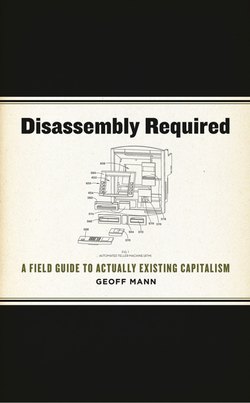Читать книгу Disassembly Required - Geoff Mann - Страница 3
На сайте Литреса книга снята с продажи.
ОглавлениеAcknowledgments
The book you hold is the product of many minds (and twice as many hands, I suppose). I would love to take sole credit for it, but ultimately the flaws are the only thing I worked out on my own. The good comes from the sharp eyes of my coworkers, students, and friends. The project began with the Purple Thistle Institute, an alternative to university run in the summer of 2011 by the Purple Thistle Centre, a youth collective in East Vancouver. The participants in the Institute brought energy and insight, and gave me the motivation I needed. I thank them all, especially Dani Aiello, who subsequently joined the Thistle collective and has been a continued help and support (as have the folks who work at the coffee shops where I did a lot of the writing, especially Derek Mensch, whose endless curiosity is a real inspiration). A few people in particular have dedicated a lot of critical energy to some complete version or another of this, and all of them have helped make it a whole lot better, especially Michelle Bonner, Kate Khatib, Carla Bergman, Matt Hern, and Sanjay Narayan.
Carla and Matt, the people behind the Thistle, are the reason this book exists. They have been enthusiastically encouraging me since I began writing, and I don’t think I have ever told them how important that has been. In addition to motivating me at the start, Matt also led me to AK, and to Kate Khatib and Charles Weigl, my awesome editors. Everyone at AK has been excellent, but Kate and Charles have gone above and beyond. So much of their work is here that I kind of feel like a co-author. Where I work, I have long leaned on Eugene McCann, Roger Hayter, Nick Blomley, Paul Kingsbury, and Ian Hutchinson (and, just as heavily, on Joyce Chen, Marion Walter, and Liliana Hill). As a “teacher” (I put it in scare quotes because it is not always clear who is teaching whom), I have had extraordinary luck, in the form of Becky Till, Calvin Chan, Emily Macalister, Michelle Vandermoor, Rebeca Salas, Stuart Hall, Victoria Hodson, Mark Kear, and Chloe Brown. Not every teacher is so fortunate, and I am very grateful. In addition, Nik Heynen, Scott Prudham, Jake Kosek, and Brett Christophers are all you could ever wish for in a most enjoyably unprofessional “professional” community. The word “colleague” does them a disservice.
I would also like to extend a special kind of gratitude to Geoff Ingham, whose work has long been a great motivator, and from whom I have learned an extraordinary amount. Geoff has also been a steadfast supporter of my own efforts, despite the fact that most of the time I am merely following in his footsteps. Anyone who knows his writing, especially his excellent book Capitalism (cited throughout) will immediately see crucial similarities between it and this book in terms of structure. Geoff has constructed the most elegant structural solution to the complex question of what constitutes the key parts of capitalism, an answer from which I drew the initial inspiration for the first part of the present work. For this and much more, I cannot thank him enough. We may come to different conclusions, but I hope very much that he will find echoes of himself in here, that he will recognize how important all his work has been to me, and that he will be proud of what he has helped bring to life.
Whether at work or beyond it, this book and anything else would be impossible without my family (extended Manns, Bonners, Dyers, and Mobbs), my friends in Vancouver (Panos, Ziff, Matt, Selena, Jess, Ry, John V., Mark J.), teammates (Specials, Generals, and Meralomas), and all the ICSF moms and dads with whom I spend countless hours shooting the breeze on rainy soccer sidelines. Finally, I am especially grateful for the friendship of Andrew Frank, Sanjay Narayan, Joel Wainwright, Brad Bryan, and Jessica Dempsey. They are who you hope everyone finds along the way. They back me up, they laugh their heads off with me, they love my kids, and drink beer at my kitchen table. I can tell, every time I see them—which is nowhere near enough—that they would do anything for me, and I sure hope they know I feel the same about them. Jess, Joel, and Sanj have played a key role in this project in particular, and much of it is the result of many long, late-into-the-night conversations with them.
Which brings me to my Michelle. Everyday I am reminded how amazingly lucky I am to grow old with her, and I just seem to get luckier (and older) by the minute. No small part of her is in this—she is much of the hope and humour I find in what can sometimes seem a dark road ahead. This book is dedicated to the source of the rest of that hope and humour: our two wonderful madmen, Finn and Seamus, the best disassemblers you’ll ever meet. It is to them and their friends that the task of reassembly falls. That, at least, is great news, because we are in very good hands.
